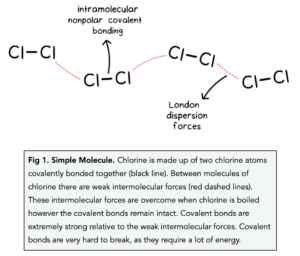Simple Molecular Covalent Structures (GCSE Chemistry)
Simple Molecular Covalent Structures
Covalent Structures
Covalent bonds are found in many substances and these can form different structures which can be split into three main categories:
- Simple Molecular
- Polymers
- Giant Covalent (Macromolecular)
Simple Molecular
- A molecule is a group of two or more atoms covalently bonded together. A substance that is formed when two or more atoms are covalently bonded together is known as a molecule. Some examples include: hydrogen (H2), water (H20) and methane (CH4). In a small molecule, you can count the number of atoms present.
- In-between each molecule there are intermolecular forces. Simple molecules are made of individual molecules and between them there are weak forces of attraction known as weak intermolecular forces. When simple molecular substances are melted or boiled, these weak intermolecular forces are overcome. They are easily overcome and do not require much energy.






Still got a question? Leave a comment
Leave a comment